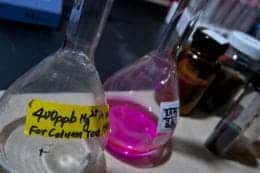It’s a bird! It’s a plane! No, it’s super sand! *tadam
Researchers from Rice University have managed to develop a new kind of filtering sand, dubbed “super sand”, which has five times the filtering properties of regular sand. The advancement could provide an indispensable, cost-effective solution for the current water crisis in developing countries where millions of people do not have access to clean water.
Simple bed sands have been used to filter water for thousands of years, its effectiveness in removing contaminants in water being dependent on the texture and the thinness of the sand grains. However, its filtering capabilities are highly limited and can prove to be highly undependable, becoming overloaded fairly quickly.
Using nanotechnology, Rice University scientists coated grains of sand with a nanomaterial called graphite oxide (GO), a product in the chemical exfoliation process of graphite (aka pencil lead) that leads to single-atom sheets known as graphene via subsequent reduction. These nanosheets of carbon can be engineered to have either hydrophobic (water-hating) or hydrophilic (water-loving) properties, and when combined with sand, the coatings adhere to the grains and thus exposure of the hydrophilic parts is ensured.

To test the effectiveness of super sand, Professor Pulickel Ajayan who lead the team of researchers from Rice, together with collaborators from Australia and Georgia conducted experiments to compare this coated sand with plain sand.
Two experimental models were employed, one containing mercury (at 400 parts per billion) and the other Rhodamine B dye (10 parts per million), each tested on plain and graphite oxide sand. After 10 minutes, plain sand became saturated and stopped filtering the mercury. The nano coated sand went on filtering for well over 50 minutes, and the resulting compound contained less than one part per billion of mercury—within the EPA’s safe rating of two parts per billion—and far below the levels left by regular sand. Results for Rhodamine B dye were similar.
The lab is looking at ways to further functionalize graphite oxide shells to enhance contaminant removal. “By attaching different functional moieties onto graphite oxide, we could engineer some form of a ‘super sand’ to target specific contaminants species, like arsenic, trichloroethylene and others,” said Rice graduate student Wei Gao, primary author of the paper.






